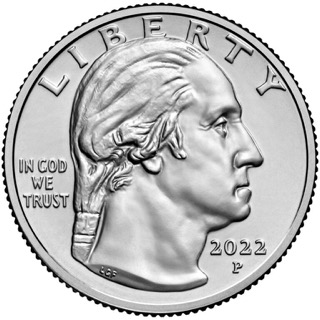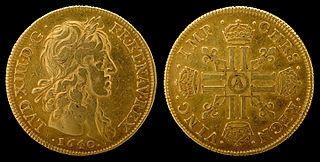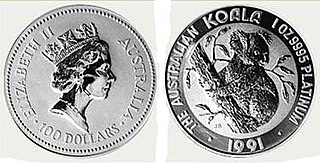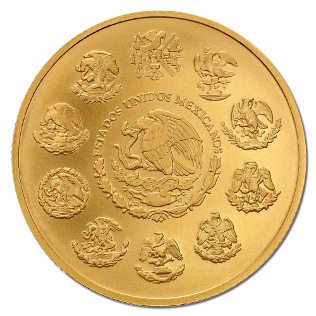
The quarter, formally known as the quarter dollar, is a denomination of currency in the United States valued at 25 cents, representing one-quarter of a dollar. Adorning its obverse is the profile of George Washington, while its reverse design has undergone frequent changes since 1998. Since its initial production in 1796, the quarter dollar has held a significant place in American numismatics, with consistent production since 1831.

The Louis d'or is any number of French coins first introduced by Louis XIII in 1640. The name derives from the depiction of the portrait of King Louis on one side of the coin; the French royal coat of arms is on the reverse. The coin was replaced by the French franc at the time of the revolution and later the similarly valued Napoléon. The actual value of the coins fluctuated according to monetary and fiscal policy, but in 1726 the value was stabilized.

The Royal Canadian Mint is the mint of Canada and a Crown corporation, operating under the Royal Canadian Mint Act. The shares of the Mint are held in trust for the Crown in right of Canada.
The fineness of a precious metal object represents the weight of fine metal therein, in proportion to the total weight which includes alloying base metals and any impurities. Alloy metals are added to increase hardness and durability of coins and jewelry, alter colors, decrease the cost per weight, or avoid the cost of high-purity refinement. For example, copper is added to the precious metal silver to make a more durable alloy for use in coins, housewares and jewelry. Coin silver, which was used for making silver coins in the past, contains 90% silver and 10% copper, by mass. Sterling silver contains 92.5% silver and 7.5% of other metals, usually copper, by mass.

Pennies are a type of coinage that were minted between 1858 and 2012 for use in the Province of Canada, and later in Canada. Each coin is worth one cent, or 1⁄100 of a dollar. While the official term for the coin is one-cent piece, the terms penny and cent predominate likely due to their English origin. Like all Canadian coins, the obverse depicts the reigning Canadian monarch at the time of issue.

The American twenty-cent piece is a coin struck from 1875 to 1878, but only for collectors in the final two years. Proposed by Nevada Senator John P. Jones, it proved a failure due to confusion with the quarter, to which it was close in both size and value.

Britannia coins are British bullion coins issued by the Royal Mint in gold since 1987, in silver since 1997, and in platinum since 2018. The reverse of the coin patterns feature various depictions of Britannia, a feminine personification of the United Kingdom while the obverse features a monarch effigy with the legend around it.

The Seated Liberty dollar was a dollar coin struck by the United States Mint from 1840 to 1873 and designed by its chief engraver, Christian Gobrecht. It was the last silver coin of that denomination to be struck before passage of the Coinage Act of 1873, which temporarily ended production of the silver dollar for American commerce. The coin's obverse is based on that of the Gobrecht dollar, which had been minted experimentally from 1836 to 1839. However, the soaring eagle used on the reverse of the Gobrecht dollar was not used; instead, the United States Mint (Mint) used a heraldic eagle, based on a design by late Mint Chief Engraver John Reich first utilized on coins in 1807.

The Manx Noble are platinum, gold or silver bullion coins distributed by the Isle of Man and minted by private companies. While platinum coins have been minted since the early 1800s, the Noble is the first platinum coin created for investors. The coins are not minted every year, but have an erratic schedule. Nobles are legal tender but they do not have a fixed face value; instead, like the Krugerrand or Mexico's Libertad, they are legal tender to the value of their precious metal content.

The Chinese Silver Panda is a series of silver bullion coins issued by the People's Republic of China. The design of the panda is changed every year and minted in different sizes and denominations, ranging from 0.5 troy oz. to 1 kilogram. Starting in 2016, Pandas switched to metric sizes. The 1 troy ounce coin was reduced to 30 grams, while the 5 troy ounce coin was reduced to 150 grams. There is also a Gold Panda series issued featuring the same designs as the Silver Panda coins.

The real was the currency of the Federal Republic of Central America from the passing of the coinage law of 19 March 1824 to the dissolution of the republic in 1838. Sixteen silver reales equaled one gold escudo, and a coin of eight reales was called a peso. The Central American Republic's real replaced the Spanish colonial real at par and continued to circulate and be issued after the constituent states left the Central American Republic. Federation coins were minted in Guatemala, Costa Rica, and Honduras, while additional provisional issues were minted at various points in Costa Rica, Honduras, and El Salvador. Both Guatemala and Costa Rica continued minting coins in the style of the republican real until the late 1840s; the currency was eventually replaced by the Costa Rican real, Salvadoran peso, Guatemalan peso, Honduran real and Nicaraguan peso.
The Canadian Silver Maple Leaf is a silver bullion coin that is issued annually by the Government of Canada since 1988. It is produced by the Royal Canadian Mint.

The Silver Kookaburra is a silver bullion coin originating from Australia, and produced at the Perth Mint starting in 1990. The coins were .999 fine silver until the 2018 edition, which increased in purity to .9999 silver. While the obverse of the coin always depicts the reigning monarch--Queen Elizabeth II during her reign and now features King Charles III, the reverse side changes every year, always featuring a kookaburra, a bird native to Australia. Due to the yearly design change and limited production of the one-ounce coins, they have higher collectible value than some other bullion coins. The Perth Mint, generally, ships the coins in individual plastic capsules. One-ounce coins ship in shrink wrap rolls of 20, with 5 rolls in each box of 100. They are minted in four sizes; 1,000 g, 10, 2 and 1 troy ounces.

The Platinum Koala is an Australian platinum bullion coin minted by the Perth Mint between 1988 and 2008. The Platinum Koala is notionally legal tender, that is a legal means of payment.

The Libertad coins are silver and gold bullion coins originating from Mexico and minted by the La Casa de Moneda de México. The Mexican Mint was established in 1535 and is the oldest mint in the Americas. The modern coins contain 99.9% silver or gold and are available in various sizes. Both metal coins have undergone a design change. In 1989, 3,500 1⁄4 ounce Libertad platinum coins were produced. Libertads are devoid of face value, yet are legal tender, still accepted as currency and guaranteed by Banco de México, based on the market value of its gold or silver content.
The America the Beautiful silver bullion coins comprise a series of silver bullion coins with a face value of a quarter dollar. The coins contain five troy ounces of silver, making them the largest silver bullion coins ever issued by the United States Mint. The design of the coins duplicates exactly—though enlarged—each of the America the Beautiful quarters. They were issued from 2010 to 2021. The coins were available for sale during the year in which their corresponding circulating coin is issued. The coins are distributed by the United States Mint's network of authorized bullion dealers, and may be resold at the discretion of the Director of the National Park Service.

The Korean Tiger Bullion Series Medal is a series of gold bullion medals issued by the Korean Minting, Security Printing & ID Card Operating Corporation (KOMSCO). The first series was introduced in June 2016. The medals are minted in the following denominations of 1/4 oz, 1/2 oz, and 1 oz of 99.99% of fine gold.

The Silver Kangaroo is a silver coin originating from Australia and produced at the Perth Mint. This is a bullion coin meant for investment in silver. An Australian silver kangaroo coin, produced at the Royal Australian Mint (RAM), is collected for its numismatic value. The obverse of the coin always depicts Queen Elizabeth II. The reverse side features a red kangaroo jumping. Unlike the Australian silver koala and silver kookaburra coins, the reverse image does not change every year. The obverse image on the RAM silver coin does change every year. The mintage every year is unlimited, unlike the koala and kookaburra coins which have a maximum mintage of 300,000 and 500,000 respectively. No special editions or privy marks have appeared for the one-ounce bullion coin.

The Archangel Michael are silver and gold bullion coins originating from Ukraine and minted by the National Bank of Ukraine.

Manx Angels are gold or silver bullion coins distributed by the Isle of Man and minted by private companies. The Isle of Man is not part of the United Kingdom. It is a Crown dependency and thus can mint its own coins. The coin depicts Archangel Michael slaying a dragon. The silver coins have not been minted every year, but have an erratic schedule. Angels are legal tender but they do not have a fixed face value; instead, like the Krugerrand or Mexico's Libertad, they are legal tender to the value of their precious metal content.


















